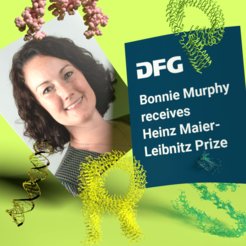Bonnie Murphy Receives Heinz Maier-Leibnitz Prize
German Research Foundation honors Murphy's research on structural elucidation of proteins involved in cellular energy metabolism
Bonnie Murphy has been an independent Max Planck Research Group Leader at the Max Planck Institute of Biophysics since 2020. She uses cryo-electron microscopy to investigate the structure and function of proteins that play a crucial role in the energy metabolism of living organisms. For her outstanding achievements, the Deutsche Forschungsgemeinschaft (DFG, German Research Foundation) awards her one of the most important prizes for early-career researchers in Germany, the Heinz Maier-Leibnitz Prize.
Text: Katharina Kaefer

“I’m very honored to receive the Heinz Maier-Leibnitz prize,” says Murphy. “It recognizes work done together with my team including Ralf Steinhilper, Olivia Pfeil-Gardiner, Victor Dubach, Pablo San-Segundo, Dongsheng (Max) Yin and Rita Zimmermann, among others.” Murphy was selected from 171 nominees as one of only 10 awardees. Since 1977, the prize has been given annually to outstanding early-career researchers to support them in pursuing their careers in academia.
During her doctoral studies at Oxford University in the United Kingdom, Bonnie Murphy worked on understanding the reasons for the speed and efficiency of redox enzymes. Such enzymes accelerate chemical reactions in living organisms and are required for almost all metabolic and energy conversion processes. As a postdoctoral researcher at the Max Planck Institute of Biophysics, Murphy described the structure of the enzyme mitochondrial ATP synthase at high resolution for the first time. This protein is located in the membrane of mitochondria, the powerhouses of the cell. It recycles the organism's universal energy carrier, the molecule adenosine triphosphate (ATP), and therefore is crucial for the cell's energy household.
Murphy has been an independent Max Planck group leader in biophysics since 2020, studying redox proteins with cryo-electron microscopy. This technique involves an electron beam penetrating snap-frozen protein samples. The interactions of the electrons with the sample produce an image. The individual images can then be processed and combined computationally to produce a high-resolution protein structure. With her team, Murphy investigates the structures of important enzyme complexes that are involved, for example, in the conversion of carbon dioxide to methane or the production of hydrogen. Murphy’s group also works to advance the techniques of cryo-electron microscopy to better understand the roles that metals and other ions play in activating and regulating protein complexes in the cell. “We’re grateful to the DFG for the generous research funding associated with this prize”, Murphy says. “The funding will support our continued work in understanding protein-based catalysts whose activity shapes our planet, our climate, and our health.”








